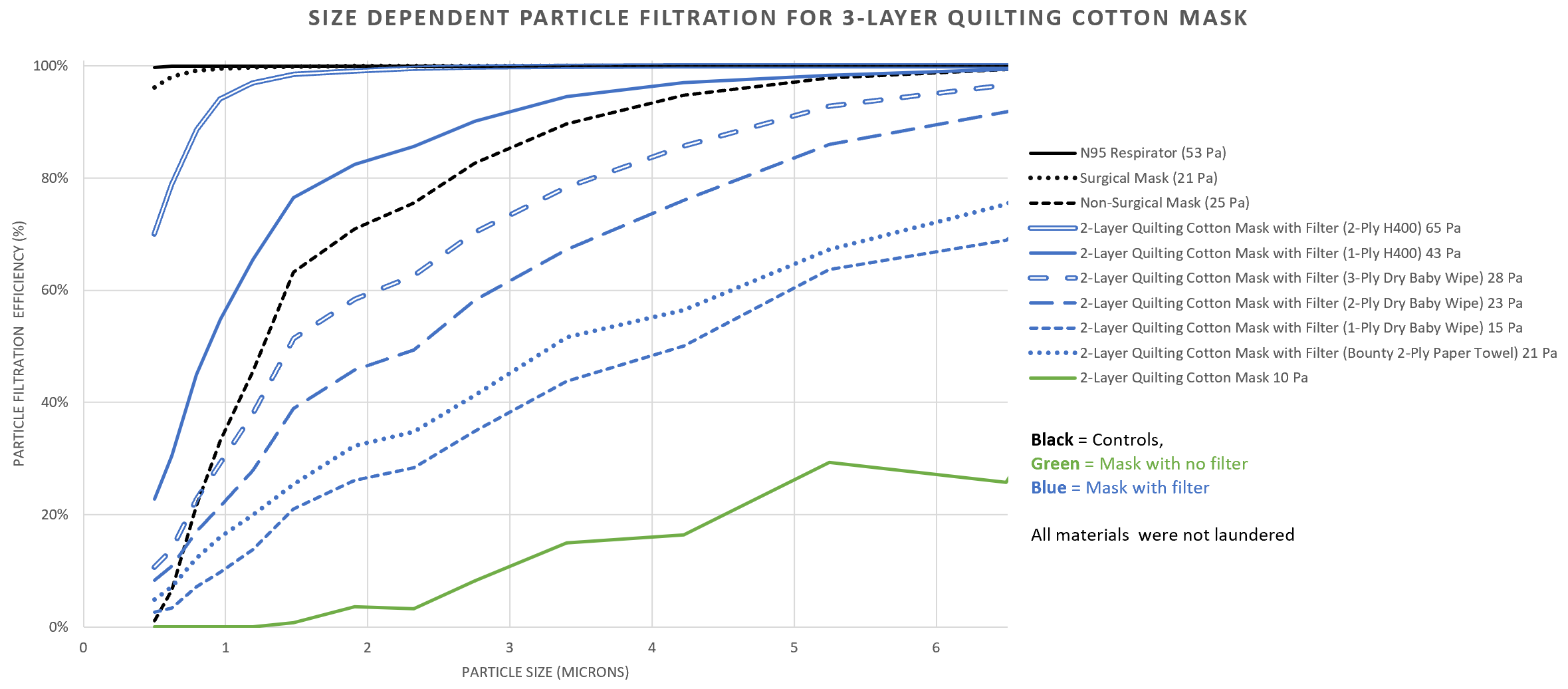
To study the effect of filter on the filtration performance and breathability (inverse of pressure drop, Pa) of fabric masks, we collaborated with the UBC Aerosol Lab to test a number of biocompatible, accessible and breathable filters. Using single-layer filtration (particle filtration efficiency of NaCl aerosols with aerodynamic sizes of 0.5-6microns) and breathability (Pressure drop, Pa) data, measured at a flow rate of 30L/min (equivalent to normal-moderate work of breathing), we estimated the filtration performance and breathability for the typical cotton mask made of quilting cotton with and without the use of filters.
- The use of biocompatible filters such as dried baby wipe (Huggies Simply Clean), paper towel (Bounty), and Halyard sterilization wrapping (H100-400) significantly improve the filtration efficiency of a cloth mask, without greatly impacting mask breathability.
- Multiple layers of dried baby wipes (2-3) and paper towels (2-4ply) need to be used to attain similar filtration efficiency as a procedural mask or non-surgical face mask. One layer of Halyard sterilization wrapping (H300-400) can achieve similar filtration efficiency as a non-surgical mask. 2-layers of Halyard sterilization wrapping (H300-400) need to be used to attain similar filtration efficiency as a surgical face mask or N95 mask.
- For a filter to be maximally effective, it needs to cover the entire surface of the fabric mask.
- Excluded from our data presentation are other filters that have been tested by the UBC Aerosol Lab or other institutions, including regular bathroom paper towel (poor breathability), coffee filter (poor breathability, ?particulate risk), floor wipes (?biocompatible), HVAC filter (?biocompatible), and microfiber towel (poor filtration performance).
Filter Sterilization
We also assessed different ways in which the filters can be sterilized and the effect of sterilization on filter filtration and breathability.
Filters can be sterilized a number of ways:
- Heat sterilization: 30min to 1 hr at 70C (oven or dehydrator)
- Washer and dryer high heat: launder along with the cloth mask in a small laundry bag
- IPA: Immerse in 70% isopropyl alcohol for 15min
- Soapy water: Immerse in soapy water with detergent for 15min, rinse and air dry

70C heat does not appear to affect the filtration performance of H400. In contrast, washer and dryer, IPA and soapy water sterilization methods all similarly reduced the filtration performance of H400 for particle sizes < 5 microns. This is likely all due to the same mechanism: the removal of electrostatic charge due to sterilization. Despite this, 1 layer of H400 after sterilization is still 300% better at filtering 3 micron particles compared to 1 layer of quilting cotton.

70C heat does not appear to affect the filtration performance of H600. In contrast, washer and dryer and soapy water sterilization methods reduced the filtration performance of H600 for particle sizes < 5 microns. This is likely all due to the same mechanism: the removal of electrostatic charge due to sterilization. H400 and H600 exhibited similar filtration performance despite their different breathability (H600 is less breathable than H400).

All 4 sterilization methods did not appear to affect the filtration performance of dried baby wipe.

Even after being laundered for 10 times, cotton mask with filter performed 50-120% better than cotton mask alone, in terms of particle filtration efficiency at the 3 micron range. All materials (including filters) in the graph had been laundered 10x using the washer and dryer (high heat) in a protective laundry bag, with the exception of controls (N95 mask, surgical mask, non-surgical mask) and the Bounty paper towel.
Take away points:
- Definitely use a filter if you want a breathable option to improve the filtration performance of your cloth mask!
- Try biocompatible filters such as dried baby wipe (Huggies Simply Clean), paper towel (Bounty), and Halyard sterilization wrapping (H100-400)
- There are many options to sterilize filters without greatly affecting its filtration efficiency